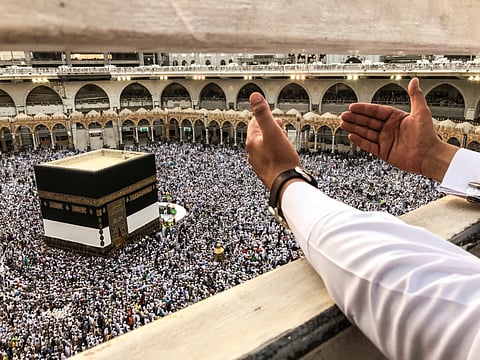Over 2 million Muslims begin Haj pilgrimage
The five-day Haj represents one of the world’s biggest gathering every year

Makkah: More than two million Muslims began the annual Haj pilgrimage on Sunday in Saudi Arabia, circling the cube-shaped Kaaba from first light in Makkah that Islam’s faithful face five times each day during their prayers.
The five-day Haj represents one of the world’s biggest gathering every year, a trip required of all able-bodied Muslims once in their life.
“We are very blessed by Allah to be in this place, and we pray to Allah to make the Islamic nations from the West to the East in a better situation,” said Essam Eddin Afifi, a pilgrim from Egypt. “We pray for the Islamic nations to overcome their enemies.”
Muslims circle the Kaaba counter-clockwise seven times while reciting supplications to Allah, then walk between the two hills traveled by Hagar. Makkah’s Grand Mosque, the world’s largest, encompasses the Kaaba and the two hills.
Before heading to Makkah, many pilgrims visit the city of Medina, where the Prophet Mohammad (PBUH) is buried and where he built his first mosque.
Muslims believe the Haj retraces the footsteps of the Prophet Mohammad (PBUH), as well as those of the prophets Ebrahim and Esmail.
After prayers in Makkah, pilgrims will head to an area called Mount Arafat on Monday, where the Prophet Mohammad (PBUH) delivered his final sermon.
From there, pilgrims will head to an area called Muzdalifa, picking up pebbles along the way for a symbolic stoning of the devil and a casting away of sins that takes place in the Mina valley for three days.
At the Haj’s end, male pilgrims will shave their hair and women will cut a lock of hair in a sign of renewal for completing the pilgrimage. Around the world, Muslims will mark the end of Haj with a celebration called Eid Al Adha. The holiday sees Muslims slaughter sheep and cattle, distributing the meat to the poor.
Major General Mansour Al Turki, the spokesman of the Saudi Interior Ministry, said that over 2 million Muslims from abroad and inside the kingdom would be taking part in this year’s Haj.
For Saudi Arabia, the Haj is the biggest logistical challenge the kingdom faces. Its ruling Al Saud family stakes its legitimacy in part on its management of the holiest sites in Islam.
King Salman’s official title is the “Custodian of the Two Holy Mosques,” at Makkah and Medina. Other Saudi kings, and the Ottoman rulers of the Hijaz region before them, all have adopted the honourary title
The kingdom has spent billions of dollars of its vast oil revenues on security and safety measures, particularly in Mina, where some of the Haj’s deadliest incidents have occurred.
The worst in recorded history took place only three years ago. On September 24, 2015, a stampede and crush of pilgrims in Mina killed at least 2,426 people, according to an Associated Press count.
The official Saudi toll of 769 people killed and 934 injured has not changed since only two days afterward. The kingdom has never addressed the discrepancy, nor has it released any results of an investigation authorities promised to conduct over the disaster.
Sign up for the Daily Briefing
Get the latest news and updates straight to your inbox

